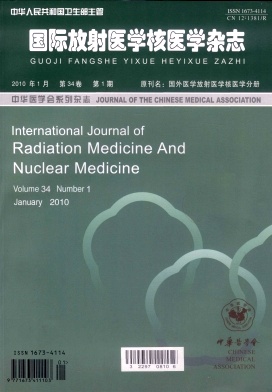-
冠心病治疗方法的进展对诊断提出了更高的要求, 核素显像是冠心病诊断的重要手段。核素显像方法种类很多, 各种方法检测的重点、意义均不相同[1]。在同一个患者中, 实施所有的核素检查项目是不可能的, 也是不必要的。如何将核素显像方案进行优化, 选择最具临床价值、最符合临床要求、最具有可行性的核素检测项目或组合项目, 需要进一步深入研究。自1991年10月至2009年6月, 我们选择临床可疑或确诊的冠心病患者4236例, 进行99Tcm标记化合物显像8873例次, 分析显像结果, 并与临床对照, 以期探讨99Tcm标记化合物显像检测冠心病的优化方案。
HTML
-
选择临床可疑或确诊的冠心病患者4236例, 其中男性3205例、女性1031例, 年龄26~91岁, 平均年龄(56.5±18.9)岁。此组病例由冠状动脉造影或临床随访证实。
-
显像仪器为GE公司生产的带符合线路和定位CT的SPECT-CT, 机型为Hawkeye Millennium VG, 配低能平行孔、99Tcm/18F双核素和符合线路准直器, 具备心电图触发门控采集功能。显像剂包括放射性核素和标记化合物, 分别由北京原子高科股份有限公司、江苏省原子医学研究所江原制药厂和山东省肿瘤医院提供。99Tcm-甲氧基异丁基异腈(99Tcm-methoxyisobutylisonitrile, 99Tcm-MIBI)每次显像剂量为555~740 MBq(1 mCi=37 MBq); 99Tcm-红细胞(99Tcm-red blood cell, 99Tcm-RBC)、99Tcm-高锝酸盐(99Tcm-sodium pertechnetate, 99TcmO4-)、99Tcm-焦磷酸盐(99Tcm-pyrophosphate, 99Tcm-PYP)每次显像的剂量均为740 MBq; 18F-FDG每次显像剂量为185~296 MBq; 201Tl每次显像剂量为111 MBq。
-
① 99Tcm-MIBI静息心肌灌注断层显像[1-2]; ②99Tcm-MIBI负荷(运动或药物)心肌灌注断层显像[3-4]; ③99Tcm-MIBI门控心肌断层显像[5-7]; ④99Tcm-RBC门控心血池显像[8-9]; ⑤静脉滴注(或含服)硝酸甘油介入99Tcm-MIBI心肌显像[10-11]; ⑥99TcmO4-首次通过法心血管造影[1]; ⑦99Tcm-PYP梗死灶阳性显像[1]; ⑧18F-FDG心肌葡萄糖代谢显像[12]; ⑨18F-FDG与99Tcm-MIBI双核素心肌显像[13-14]; ⑩201Tl心肌显像[15-16]。
-
按临床诊断要求, 将核素显像各项目分为8个方案。方案一: 可疑冠心病确诊或排除[1-4], 检测病例数1349例; 方案二: 心肌缺血检测[17], 检测病例数1796例; 方案三: 陈旧性心肌梗死检测[12-14], 检测病例数984例; 方案四: 急性心肌梗死诊断[18-19], 检测病例数107例; 方案五: 心肌存活评价[10-14], 选择的检测病例数210例; 方案六: “罪犯”血管检测[20-21], 选择的检测病例数146例; 方案七: 缺血性心肌病诊断[22], 选择的检测病例352例; 方案八: 疗效评价[23], 选择的检测病例74例。其中, 方案一至四为冠心病常用诊断要求; 方案五至八为冠心病临床特需诊断要求, 选择的病例在前四个方案的病例总数内。
将每一方案的核素显像各项目分为四个层次: 第一层为首选项目, 是达到临床诊断要求的必做项目; 第二层为次选项目, 是能为临床提供更充分的诊断信息, 或诊断价值大但对仪器或放射性药物要求较高的项目; 第三层为可选项目, 是非临床诊断要求的优势项目, 但对临床有一定帮助; 第四层为特选项目, 是临床或科研特别需要的项目。
显像方法中, 各项目的序号(①~⑩)规定为该项目的简明代号。在同一层次内, 多个项目相加时, 为一个组合项目, 此组合内的项目全做, 并按排列次序作为检查的时间次序; 无相加标志时为可选其中之一, 次序以临床常用者为先(表 1)。
方案 诊断要求 首选项目 次选项目 可选项目 特选项目 方案一 可疑冠心病的确诊或排除 ①99TC--MiBi静息心肌灌注断层显像+②99TCm-MIBI负荷(运动或药物)心肌灌注断层显像 ③门控99Tcm-MIBI心肌断层显像 ④99Tcm-RBC门控心血池显像;⑦99Tcm-PYP梗死灶阳性显像 其他项目 方案二 心肌缺血检测 ①99Tcm-MIBI静息心肌灌注断层显像 ②99Tcm-MIBI负荷(运动或药物)心肌灌注断层显像 ③门控心肌99Tcm-MIBI心肌断层显像;④99Tcm-RBC门控心血池显像 其他项目 方案三 陈旧性心肌梗死检测 ①99Tcm-MIBI静息心肌灌注断层显像 ④99Tcm-RBC门控心血池显像;③99Tcm-MIBI门控心肌断层显像 ②99Tcm-MIBI负荷(运动或药物)心肌灌注断层显像 其他项目 方案四 急性心肌梗死诊断 ①99Tcm-MIBI提前静息心肌灌注断层显像 ⑦99Tcm-PYP梗死灶阳性显像④99Tcm-RBC门控心血池显像 ③99Tcm-MIBI门控心肌断层显像 其他项目 方案五 心肌存活评价 ①99Tcm-MIBI静息心肌灌注断层显像+⑤静滴(或含服)硝酸甘油介入99Tcm-MIBI心肌显像 ②99Tcm-MIBI负荷(运动或药物)心肌灌注断层显像;⑨ 18F-FDG与99Tcm-MIBI双核素心肌显像;⑧18F-FDG心肌葡萄糖代谢显像 ⑩201Tl心肌显像。 其他项目 方案六 “罪犯”血管检测 ①99Tcm-MIBI静息心肌灌注断层显像+②99Tcm-MIBI负荷(运动或药物)心肌灌注断层显像+⑤静滴(或含服)硝酸甘油介人99Tcm-MIBI心肌显像 - ⑨l8F-FDG与99Tcm-MIBI双核素心肌显像;⑧l8F-FDG心肌葡萄糖代谢显像 其他项目 方案七 缺血性心肌病诊断 ①静息99Tcm-MIBI心肌灌注断层显像+④99Tcm-RBC门控心血池显像 - - 其他项目 方案八 疗效评价 ①静息99Tcm-MIBI心肌灌注断层显像+④99Tcm-RBC门控心血池显像 ②99Tcm-MIBI负荷(运动或药物)心肌灌注断层显像;③门控99Tcm-MIBI心肌断层显像 ⑥99TcmO4-首次通过心血管造影 其他项目 注:表中“-”表示该栏目中无可选项目;99Tcm-MIBI为99Tcm-甲氧基异丁基异腈;99Tcm-RBC为99Tcm-红细胞;99TcmO4-为99Tcm-高锝酸盐;99Tcm-PYP为99Tcm-焦磷酸盐;18F-FDG为l8F-氟脱氧葡萄糖。
1.1. 病例资料
1.2. 主要仪器和显像剂
1.3. 核素显像常用项目
1.4. 优化方案的表达格式
-
4236例患者的检测结果见表 2。结果显示, 方案一至方案四的首选项目皆为99Tcm标记化合物显像项目, 能够很好的完成冠心病的临床常用诊断要求。
病例分类 例数 检测方法 真阳性/阳性例数 真阴性/阴性例数 准确率(%) (真阳性+真阴性例数)/病例数 可疑冠心病组 1349 方案一 562/649 675/700 91.7 1237/1349 心肌缺血组 1796 方案二 1796/1674 0/122 93.2 674/1796 陈旧性心肌梗死组 984 方案三 984/967 0/17 98.3 967/984 急性心肌梗死组 107 方案四 107/107 0/0 100 107/107 合计 4236 3449/3397 675/839 94.1 3985/4236 -
210例冠脉造影确诊的冠心病患者用方案五组合显像, 与经皮冠状动脉介入治疗(percutaneous-coronary intervention, PCI)后的疗效比较, 证实该方案首选项目检测存活心肌的准确率为86.2%(181/210)。
-
146例冠脉造影确诊的冠心病多支血管病变患者用方案六组合显像, 与PCI后的疗效对比, 显示该方案首选项目检测“罪犯”血管的准确率为95.9%(140/146)。
-
352例冠心病并缺血性心肌病患者用方案七组合显像, 结果显示, 该方案首选项目在本病中有明显的影像特点, 对比临床诊断结果, 该方案诊断缺血性心肌病的准确率为92.3%。
-
74例接受血流重建治疗的患者用方案八组合显像进行疗效评价, 结果显示, 74例患者经临床评价: 治愈5例, 好转63例, 无效6例, 有效率为91.9%(68/74);方案八首选项目评价: 显效7例, 有效62例, 无效5例, 有效率为93.2%(69/74), 与临床评价接近。
2.1. 冠心病常用诊断要求完成情况
2.2. 冠心病临床特需诊断要求完成情况
2.2.1. 存活心肌检测
2.2.2. “罪犯”血管检测
2.2.3. 缺血性心肌病诊断
2.2.4. 疗效评价
-
本研究选择4236例临床确诊或可疑的冠心病患者进行了99Tcm标记化合物显像, 通过显像结果分析, 尝试提出了99Tcm标记化合物显像检测冠心病的优化方案。其应用结果显示, 在可疑冠心病的诊断中, 采用静息加运动99Tcm-MIBI心肌显像, 即可确诊或排除冠心病的存在, 准确率达91.7%。针对此类病例的诊断, 本方案强调运动试验的重要性, 运动显像可明显提高检出率和准确性。对于心肌缺血、陈旧性心肌梗死的检测和急性心肌梗死的诊断, 通过静息99Tcm-MIBI心肌显像单一项目, 既可了解心肌缺血的部位、范围和程度, 又可直观有无心脏扩大和心室重构, 其检测准确性高, 克服了核素显像检查步骤繁琐的缺陷。对临床特需的检测要求, 如存活心肌检测、“罪犯”血管检测、缺血性心肌病诊断、疗效监测等, 采用本方案所列的首选项目检测, 也有较高的准确性。本组病例检测方案的首选项目均为组合项目, 弥补了单一项目信息量不足的缺陷。
本组病例结果表明,本优化方案在冠心病检测 中准确、可行,符合高效原则。采用本方案的首选 项目,简化了检测程序,减少了检测项目,缩短了 检测时间,方便了临床应用,提高了工作效率,符 合简便原则。本优化方案的首选项目均为99Tcm标记化合物显像项目,其显像剂供应充分、价格相对 低廉、检测费用便宜,降低了运行成本,减轻了患 者负担,符合节约原则,利于将核素显像这一优势 项目在临床冠心病诊断中推广应用。
此优化方案立足于99Tcm标记化合物显像, 与201Tl相比, 核素更易得, 费用更低廉, 图像质量更好。在心肌存活的检测中, 虽然99Tcm标记化合物显像的准确率略低于18F-FDG代谢显像, 但却明显降低了检测条件和成本, 其性价比更高。应用的检测仪器也以普通SPECT或能够进行正电子成像的SPECT-CT为主, 较PET或PET-CT的检测成本与条件更低, 也利于临床的普及应用。未来随着核心脏病学的发展, 新的更优越的核素显像剂、显像仪器和显像方法不断应用, 本方案也会随之改进, 以进一步达到对冠心病全面诊断的要求。








 DownLoad:
DownLoad: